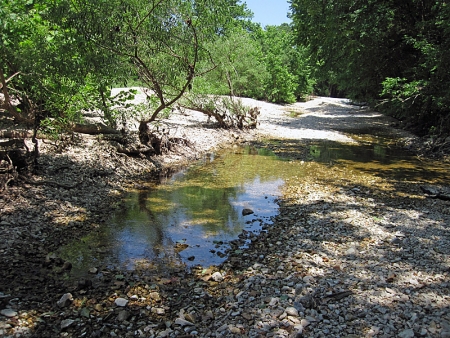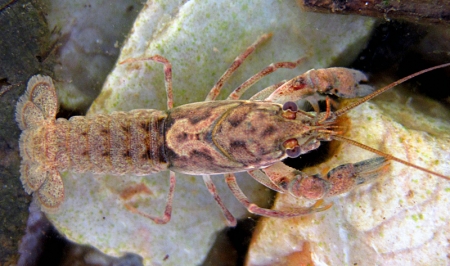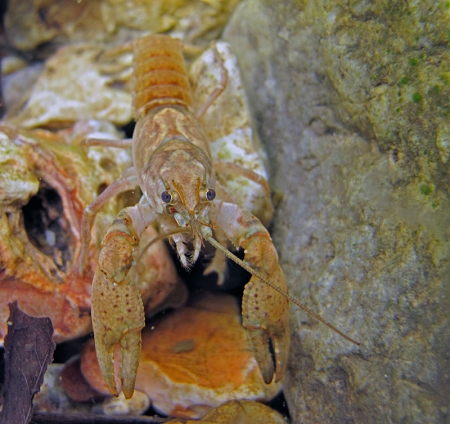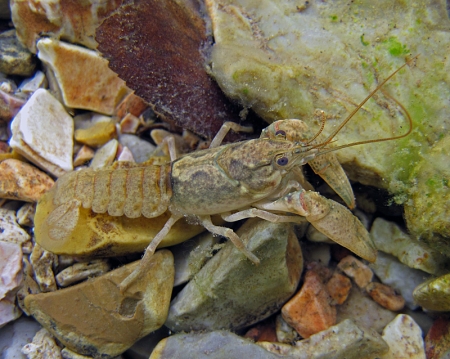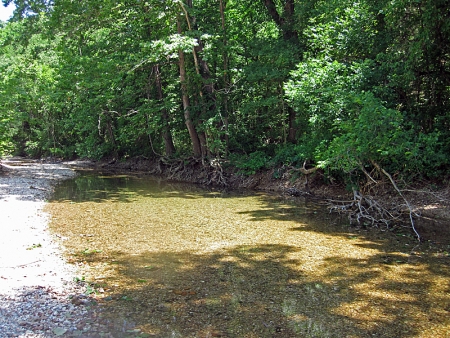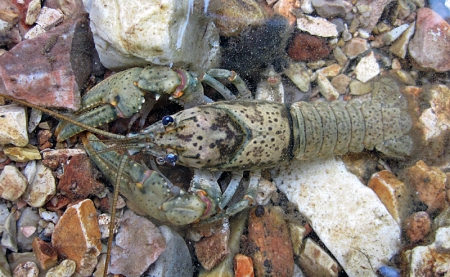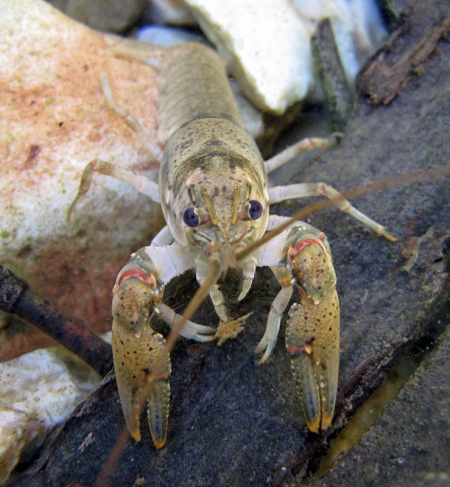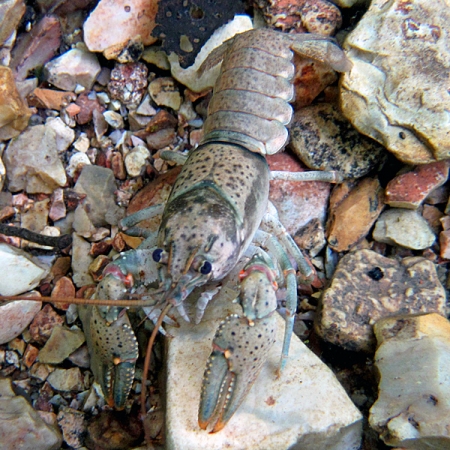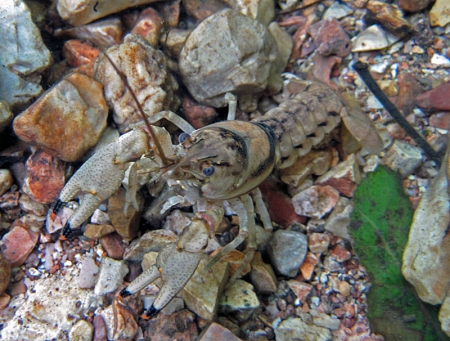Most of the Ozark stream crayfish species are relatively easy to find. Grab your copy of The Crayfishes of Missouri (you have a copy, right?,) look up the species you’re interested in, use the handy range map to identify a drainage where it occurs and then find a public access or three in that drainage. This works for almost all of our species because they are either limited to a small, specific range or common enough over a larger range that once you locate an area with appropriate habitat, you’re going to find the crayfish you’re looking for.
But what if you’re looking for Orconectes meeki or O. williamsi? According to Pflieger, O. meeki “has been collected only in a few tributaries of Table Rock Lake (White River Drainage) in Stone County” and O. williamsi “has a very localized distribution in the upper White River drainage.” We’re further told that both species are found in small, clear creeks. Ok, that puts us in the right neighborhood, but we don’t know the which street. Unfortunately, the distribution maps included in the book offer no help because they’re too small to show anything as small as the creek drainages we’re dealing with here.
I spent a good deal of time over the winter of 2010-2011 reading everything I could find on these two species, pouring over maps and looking at potential sites with Google Earth. It turns out that O. meeki has been located in Missouri in streams outside Stone County since Pflieger’s book was published in 1997, so that allowed me to expand the scope of my search. I finally identified a small creek in Barry Count that looked to be a good candidate for both species and has a nice stretch running through public land. It also appeared to be intermittent based on the view of the area from Google Earth. Barry County is 3 1/2 hours from where I live, so the possibility of finding both species at a single site was definitely an added attraction. Now it was just a matter of driving over and having a look.
Which is why Independence Day weekend, 2011 found Dayna, her brother Billy and myself on the road to Springfield and then turning southwest to Barry County. My target creek was a tributary of Table Rock Lake and the stretch I was interested in was located within a few miles of the lake, so I was worried about holiday traffic in the area. My fears turned out to be unfounded. The creek is accessed from a county road and in the hour or so we were there, not a single car came by.
The creek was definitely intermittent and reduced to a few isolated pools. It appeared to have carried a much, much larger volume of water earlier in the year, judging by the size of the gravel deposits. Not terribly surprising since April, 2011 saw record rainfall all across the Ozarks. The water in the pools was cool and fresh feeling so I’d say there’s a healthy flow of water through the gravel.
The first pool we checked was shallow (no more than 6” deep) and maybe 30’ x 10’. It was also full of crayfish, both O. meeki and O. williamsi. All of that research had just paid off.
O williamsi,with three times the numbers of O. meeki, was the dominant species, at least in this tiny pool. The biggest problem here was that the water was so shallow that it was difficult to get the camera in the water and still have the targeted crayfish fit in the frame. All of the O. williamsi were small, none being much longer than an inch or so though the species can reach 2”.
Not far downstream was a second, significantly larger pool. This one was approximately two hundred feet long, twenty-five feet wide and reached a depth of roughly two feet.
The species composition changed completely from the first pool with O. meeki being far and away the most numerous.
O. meeki can reach over two inches in length and several were very close to this figure. Many of them were somewhat soft, having recently molted though we were unable to find any discarded molts. O. meeki strongly resembles O. ozarkae, a species that it sometimes occurs in association with. O. meeki has a prominent dark spot at the base of the moveable finger that is lacking in O. ozarkae. And while both species have two dark saddle marks across the carapace, they are much more prominent in O. ozarkae.
We found no O. williamsi in this pool and a single O. neglectus.
The O. neglectus was also soft-shelled and this time locating the discarded molt was easy since he was still sitting on it. I was surprised that there weren’t more O. neglectus present because they’re almost always the dominant species wherever they occur. I suspect that the lack of permanent flow in the creek limits the species’ population size. Both O. meeki and O. williamsi will burrow to escape drying and I cannot find any reference to suggest that O. neglectus does so as well.
Dayna was terribly carsick and waiting in the car for us, so we didn’t continue down the creek. But we had already found and photographed both of our target species, two of the rarest in the state, so leaving so quickly didn’t seem like the crime it normally would have.
| References: |
| DiStefano, R.J., D.D. Magoulick, E.M. Imhoff and E.R. Larson. 2009. Imperiled crayfishes use hyporheic zone during seasonal drying of an intermittent stream. Journal of the North American Benthological Society. 28:142-152 |
| DiStefano, R. J., S. S. Herleth-King, and E. M. Imhoff. 2008. Distribution of the imperiled Meek’s crayfish (Orconectes meeki meeki, Faxon) in the White River drainage of Missouri, U.S.A.: associations with multi-scale environmental variables. Freshwater Crayfish 16:27–36. |
| Pflieger, W.L. [B. Dryden, editor]. 1996. The Crayfishes of Missouri. Missouri Department of Conservation, Jefferson City, Missouri. 152 pp. |
| Westhoff, J. T., J. A. Guyot, and R. J. DiStefano. 2006. Distribution of the imperiled Williams’ crayfish (Orconectes williamsi) in the White River drainage of Missouri: associations with multi-scale environmental variables. American Midland Naturalist 156:273–288. |
